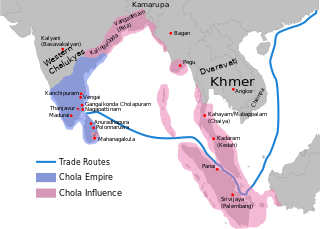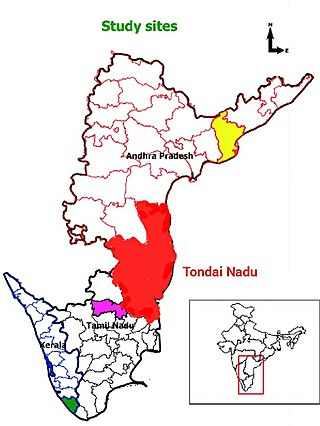Related Research Articles

The Pandyan dynasty, also referred to as the Pandyas of Madurai, was an ancient Tamil dynasty of South India, and among the four great kingdoms of Tamilakam, the other three being the Pallavas, the Cholas and the Cheras. Existing since at least the 4th to 3rd centuries BCE, the dynasty passed through two periods of imperial dominance, the 6th to 10th centuries CE, and under the 'Later Pandyas'. Under Jatavarman Sundara Pandyan I and Maravarman Kulasekara Pandyan I, the Pandyas ruled extensive territories including regions of present-day South India and northern Sri Lanka through vassal states subject to Madurai.

The Pallava dynasty existed from 275 CE to 897 CE, ruling a significant portion of the Deccan, also known as Tondaimandalam. The Pallavas played a crucial role in shaping in particular southern Indian history and heritage. The dynasty rose to prominence after the downfall of the Satavahana Empire, whom they had formerly served as feudatories.

Simhavishnu also known as Avanisimha son of Simhavarman III and one of the Pallava kings of India, was responsible for the revival of the Pallavan dynasty. He was the first Pallava monarch whose domain extended beyond Kanchipuram (Kanchi) in the South. He was portrayed as a great conqueror in Mattavilasa Prahasana, a drama written by his son Mahendravarman I.

Aditya Chola I, the son of Vijayalaya Chola, was the Hindu Chola king who laid the foundation of the Chola Empire with the conquest of the Pallava Kingdom and the occupation of the Western Ganga Kingdom and Kongu Nadu. Aditya Chola I was succeeded by his eldest son Parantaka Chola I.
Jatavarman Sundara I, also known as Sadayavarman Sundara Pandyan, was a emperor of the Pandyan dynasty who ruled regions of Tamilakkam, Northern Sri Lanka and Southern Andhra between 1250–1268 CE. He is remembered for his patronage of the arts and tamil architecture, along with refurbishment and decoration of many Kovils (temple) in the Tamil continent. He oversaw a massive economic growth of the Pandyan empire. On the eve of his death in 1268 CE, the second Pandyan empire's power and territorial extent had risen to its zenith till Nellore and Kadapa by defeating Telugu Chola ruler Vijaya Gandagopala alias Manumasiddhi II of Nellore Cholas and Ganapatideva of Kakatiyas.

The Chola dynasty was a Tamil dynasty originating from southern India. At its height, it ruled over the Chola Empire, an expansive maritime empire. The earliest datable references to the Chola are from inscriptions dated to the 3rd century BCE during the reign of Ashoka of the Maurya empire. The Chola empire was at its peak and achieved imperialism under the Medieval Cholas in the mid-9th century CE. As one of the Three Crowned Kings of Tamilakam, along with the Chera and Pandya, the dynasty continued to govern over varying territories until the 13th century CE.

Vijayalaya Chola was a descendant of the Early Cholas, who revived the Chola dynasty and founded the Imperial Chola Empire. He ruled over the region to the north of the river Kaveri. He is one of the descendants of the famous Sangam age Chola king, Karikala Chola. According to the Anbil plates of Parantaka Chola II, his predecessor is Srikantha Choladhiraja, a Telugu Chola king who ruled the Renadu region, belongs to the Pottapi Chola lineage, and is a descendant of the ancient Tamil king, Karikala Chola. Vijayalaya was succeeded by his son Aditya Chola I who laid the foundation of the Imperial Chola Empire.

Parantaka Chola I was a Chola emperor who ruled for forty-eight years, annexing Pandya by defeating Rajasimhan II and in the Deccan won the Battle of Vallala against Rashtrakutas which happened before 916 CE. The best part of his reign was marked by increasing success and prosperity.

The Chola Empire, which is often referred to as the Imperial Cholas, was a medieval Indian, thalassocratic empire that was established by the Pottapi branch of the Chola dynasty that rose to prominence during the middle of the ninth century and united southern India under their rule.

Maravarman Kulasekara Pandyan I was a Pandyan emperor who ruled regions of South India between 1268–1308 CE, though history professor Sailendra Sen states he ruled until 1310. In 1279 CE, Maravarman Kulasekara Pandyan ended the rule of Chola dynasty by defeating Rajendra III of Cholas and Ramanatha of Hoysalas. His death lead to the Pandyan Civil War in 1308–1323.
Kadungon was a Pandya king who revived the Pandya rule in South India in the 6th century CE. Along with the Pallava king Simhavishnu, he is credited with ending the Kalabhra rule, marking the beginning of a new era in the Tamil speaking region.
Maravarman Sundara Pandyan I was a Pandyan king, who ruled regions of South India between 1216–1238 CE. He laid the foundation for the Pandya revival, after being dominated by the Chozhas for several centuries.
Maravarman Rajasimha I, also known as Pallavabhanjana, was a Pandya king of early medieval south India. He was the son and successor of Ko Chadaiyan Ranadhira. He remembered for his important successes against the Pallavas and in the Kongu country.
Arikesari Maravarman, also known as Parankusa, was a Pandya king of early medieval south India.
Dantivarman was an Indian monarch who ruled the Pallava kingdom from 795 to 846 CE. He was the son of Nandivarman II and his queen, the Rashtrakuta princess Reva.

Srimara Srivallabha was a Pandya king of early medieval south India.

Tondaimandalam, also known as Tondai Nadu, is a historical region located in the northernmost part of Tamil Nadu and southernmost part of Andhra Pradesh. The region comprises the districts which formed a part of the legendary kingdom of Athondai Chakravarti. The boundaries of Tondaimandalam are ambiguous – between the river basins of Penna River and Ponnaiyar River. During the reign of Rajaraja I, this region was called as Jayankonda Cholamandalam.

Arisil or Aricil is a branch of the river Kaveri in the Tanjore district. It was the site of many a battle between the different Tamil kingdoms. One of the most notable being the 9th-century war between Nripatunga Pallava and Sri Mara Pandya in which the latter was defeated. Nripatunga was the son of Nandivarman III by a Rashtrakuta princess
The siege of Madurai in 862 resulted in the seizure and sack of the city of Madurai, capital of the Pandya Empire then ruled by Srimara Sri Vallabha. A part of Sena II's retaliatory campaign against the devastation caused by Pandya incursions during his predecessor, the invasion ended in a decisive victory for the Anuradhapura king, with the death of Srivallabha and the coronation of prince Varaguna II by general Kuttaka.
Srikantha Chola was a Telugu Chola ruler belonging to Pottapi Chola family which claims descent from ancient Tamil king Karikala Chola. He was ruling Renadu region as a feudatory of Pallavas. Srikantha was succeeded by Vijayalaya Chola although the relation between the two is not yet known.
References
- 1 2 Coedès, George (1968). Walter F. Vella (ed.). The Indianized States of Southeast Asia. trans.Susan Brown Cowing. University of Hawaii Press. p. 107. ISBN 978-0-8248-0368-1.
- ↑ Sen, Sailendra (2013). A Textbook of Medieval Indian History. Primus Books. pp. 41–42. ISBN 978-9-38060-734-4.
- 1 2 Sen, Sailendra Nath (1999). Ancient Indian History and Civilization. New Age International. ISBN 978-81-224-1198-0.
- 1 2 Hudson, D. Dennis (25 September 2008). The Body of God: An Emperor's Palace for Krishna in Eighth-Century Kanchipuram. Oxford University Press. ISBN 978-0-19-045140-0.
- ↑ Jaques, Tony (2007). Dictionary of Battles and Sieges. Greenwood Publishing Group. p. 1005. ISBN 978-0-313-33539-6.
- 1 2 University, Vijaya Ramaswamy, Jawaharlal Nehru (25 August 2017). Historical Dictionary of the Tamils. Rowman & Littlefield. ISBN 978-1-5381-0686-0.
{{cite book}}: CS1 maint: multiple names: authors list (link) - ↑ Sastri, K.A. Nilakanta (1976). A History of South India from Prehistoric Times to the Fall of Vijayanagar. Oxford University Press. ISBN 978-0-19-560686-7.
- ↑ Sastri, K. A. Nilakanta. (1929) The Pandyan Kingdom. London, Luzac and Company. 74–76.
- ↑ The Pandyan Kingdom. London: Luzac and Company. 1929. pp. 74–76.
- ↑ Sastri, K. A. Nilakanta (1949). "Takuapa and its Tamil Inscription". Journal of the Malayan Branch of the Royal Asiatic Society. 1 (147): 25–30. JSTOR 41560492.
- ↑ Division, Publications. THE GAZETTEER OF INDIA Volume 2. Publications Division Ministry of Information & Broadcasting. ISBN 978-81-230-2265-9.
- ↑ S, Suja (30 January 2021). "Nandhi Kalambagam's Agam Songs and its Rhetoric". International Research Journal of Tamil. 3: 247–254. doi: 10.34256/irjt21127 .
- ↑ Indian History. Allied Publishers. ISBN 978-81-8424-568-4.
- ↑ Patro, Kartikeswar (10 May 2021). Ancient Indian History. BFC Publications. ISBN 978-93-91031-86-2.